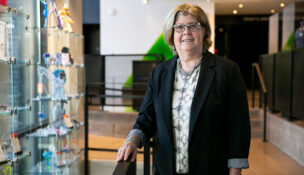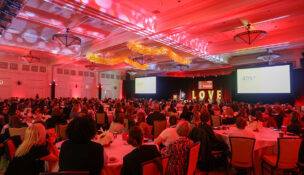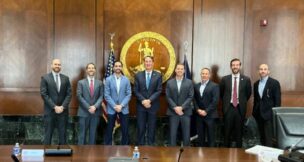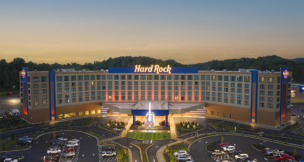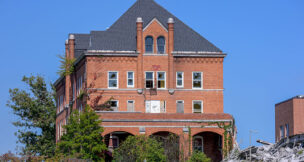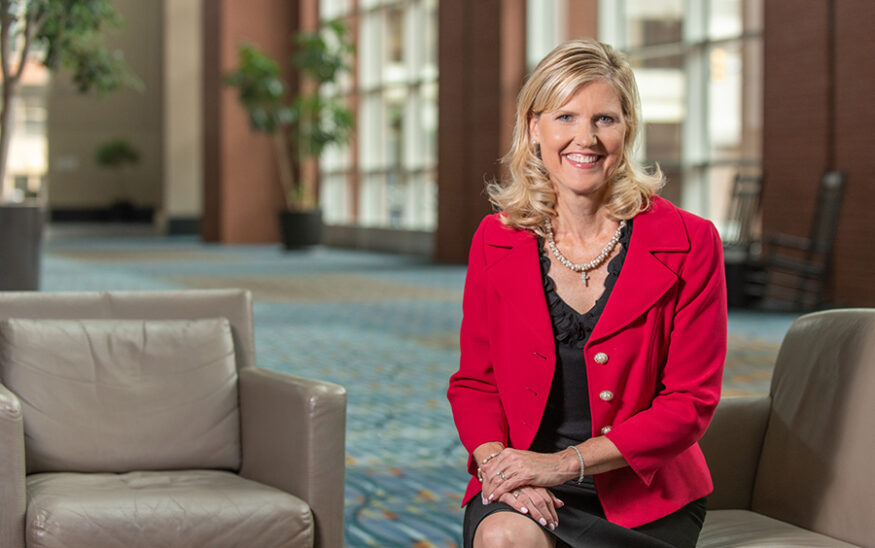
In-person conventions are back, keeping Convention Connections’ Diane Malloy busy. Photo by Caroline Martin

In-person conventions are back, keeping Convention Connections’ Diane Malloy busy. Photo by Caroline Martin
Live conventions return but face rising costs
Elizabeth Lake //November 1, 2025//
Summary
- Virginia’s meetings and events industry surpasses pre-COVID levels.
- Rising AV, production costs challenge planners.
- Smaller, intentional gatherings and unique venues grow in popularity.
It’s no secret the pandemic was tumultuous for the event planning and management industry. Innumerable meetings and conventions were canceled or postponed — or perhaps never even came to fruition. But now, a few years after the pandemic sent shockwaves across the economy, the meetings and convention space is back, and some planners in Virginia say they’re even bigger and better than ever.
“Things are incredibly busy for us right now,” says Marty Malloy, co-owner and principal of Henrico County-based Convention Connections. “We’re back to pre-COVID numbers and probably will exceed them this year. We’ve seen everything roar back with regard to in-person meetings.”
Malloy, whose company serves a wide variety of clients, including national associations, larger network marketing groups and even the 2025 CrimeCon in Denver, says he remembers the 18 months or so during the pandemic when live events were essentially dissolved. Now, though, the demand for live events is almost overwhelming, says Diane Malloy, also a principal and co-owner of Convention Connections.
“We’re drinking from fire hoses right now, the two of us,” says Diane Malloy, who runs the business with her husband. “We went through that whole COVID period where we were renegotiating a lot of their contracts because they were obviously needing to move them, and we had to do that multiple times. Then, ultimately, they settled into the flow again.”
Diane Malloy says it’s been so busy, in fact, many of the clients they work with don’t have big enough hotel room blocks booked to accommodate the contracts that were written a few years ago. Convention Connections is actually needing to get more hotel rooms for clients.
“We’re just seeing it all come back,” Diane Malloy says. “We’re seeing record numbers with quite a few of our clients.”
That’s thanks to human nature: People want to interact and network in person, Marty Malloy says, adding certain event and convention elements like exhibition halls just aren’t effective in a virtual format.
“I mean, you can try to do it, but it’s nothing like being in person,” he says. “The mentorship, the ancillary networking that goes on at these events. … It’s just people want to be around people. That’s just something that was definitely a different mindset during COVID.”
Increasing costs
Meanwhile, however, costs for events are on the rise, thanks to inflation and the implementation of President Donald Trump’s tariffs affecting a wide array of industries, including events, meetings and conventions.
Expenses related to meetings and conventions are far more expensive than they used to be just a few years ago. According to the American Hotel & Lodging Association’s 2025 State of the Industry Report, the average daily rate for a hotel is about 54% higher than it was in 2020. In a January survey of 517 meeting professionals by Meetings Today, 89.6% of respondents identified increasing costs — including for audio-visual services, food and beverage, accommodations and hotel contracts — as one of the three greatest challenges they foresaw for planning meetings in 2025.

“Cost remains the biggest challenge worldwide. Virginia is no exception,” says Cheryl Simmons, director of development and events at Child Evangelism Fellowship. Simmons, who is based in Virginia Beach, also serves as the director of member care on the board of directors for the Virginia chapter of Meeting Professionals International (MPI). During her 20-plus years in events, she has also worked with several Fortune 500 companies.
One of the largest costs, both the Malloys and Simmons mentioned, is the rising price of audio-visual equipment and professionals. Brittany Rice, director of sales for Colonial Williamsburg Resorts, also says she’s seen an increase in AV throughout most of their events, whether it’s adding a digital or virtual component.
“The cost to do the production of events and the AV has gone up tremendously,” Marty Malloy says. “Previously, that was almost an afterthought, to a degree.”
But now that companies and organizations want to share their live event experiences online through videos, the demand for those services — and the expectations for the end results — are higher.
“Years ago, storytelling was an afterthought,” Simmons says. “Video clips and social media posts were nice to have, but not central. Today, it’s one of the most important aspects of any event.”
Now that AV has become one of the top expenses for most events, Simmons suggests booking regional companies instead of national firms, bundling services into one contract, repurposing staging from past events and using in-house teams to save money.
Budget concerns
Rising costs have forced some clients to make budget cuts to events and meetings. Rice says 2023 marked a return of “full-speed-ahead” meetings and conventions, but 2025 was an adjustment period getting used to funding cuts.
“We were seeing a lot of short-term bookings just because of the uncertainty with what budgets were going to be and where funding was coming from,” says Rice, who also serves as vice president of finance on the executive committee of the board for MPI Virginia. But, she adds, “we still see a great continued need and want for group business.”
By short-term bookings, Rice says she means a short amount of time between when a client is filling out a request for proposals and when a contract is signed. Meeting professionals may have previously seen where an RFP went out and a customer wasn’t ready to move forward with that piece of business for anywhere from six months to a year, and that piece of business may not be for two more years out. Now, they’re seeing people submit an RFP for an event they want to book in a month or two months from now.
“I think it really comes down to the funding,” Rice says. “They don’t know if they’ll have the funds to be able to have that event or meeting, and so booking far out puts them at risk for an expense that maybe they won’t have funding for.” That makes flexibility and contractual commitments all the more important these days, she adds.
Simmons suggests partnering with local vendors and universities that can provide student musicians, catering and interns to cut down on cost. Hybrid formats (having both in-person attendance and virtual guests) can also reduce travel and lodging costs while expanding reach, she says.
“Regional venues — from historic churches to university halls and vineyards — provide affordable spaces with character,” Simmons adds. “Off-season planning can also create dramatic savings, [like] the coast in early spring or the mountains in late fall.”
The meetings and convention industry remains busy, but sometimes smaller events that offer a unique experience pack a better punch.
“Our approach to events is always personal. Less ballroom, more connection,” says Jen Boersma, director of brand acquisitions at Foley PR, based in Warren County. “If you’ve invited people into the room, let’s make sure they leave talking about it.”
In Virginia, Boersma says she’s seeing a rise in thoughtful, small-format meetings and events that “feel elevated, but intimate.” Some companies and brands are opting for smaller gatherings instead of large expos or trade shows, she says.
Being intentional
Now that companies are spending more money on AV elements, Boersma says she’s seeing more brands lean into editorial-style experiences that are “highly curated and photo ready,” whether the photo and video assets from the event are for internal or external purposes. That might include elements like guided breathwork sessions before a panel, interactive art installations or creative workshops, she says.
“In Virginia, we’re also lucky to have access to some truly unique venues,” she says. “Farms, historic homes [and] boutique hotels [add] so much character to the experience.”
And while in-person events are back in style, there’s a caveat, Boersma says.
“They have to be worth showing up for,” she says. “That means better food, better flow and better energy. The key now is to make it feel intentional, not obligatory.”
In Colonial Williamsburg, off-site excursions and unique experiences are particularly popular, Rice says, like incorporating local food and beverage items, attending a fife and drum march, or visiting a historic tavern, the Governor’s Palace or the reconstructed Capitol building.
“There are certain things that we can offer at Colonial Williamsburg that you will not get anywhere else in the world, just because of what we have in terms of our ties to the world’s largest living history museum,” she adds.
Simmons says she’s also witnessed how much the meetings and conventions space has changed over the years — and how more intentionally planned events are the present and future for the industry. In Virginia, that could include adding a shopping excursion, hiking the Shenandoah National Park trails or taking a private boardwalk cruise in Virginia Beach, she adds.
“Today it’s not about how many people you gather, but who you gather — and why,” she says. “It’s no longer just about producing a conference, but about creating meaningful environments where the right people come together to learn, collaborate and spark real change.”
Simmons gave the example of an event she worked on with a “high-capacity, nonprofit board” in which she encouraged members to invite people from their own personal lives to attend who might resonate with the mission of the group. One member invited a longtime friend who made a six-figure donation to the organization after being moved by the information shared at the conference.
“This is what our industry is about,” Simmons says. “We are made to gather the right people — not just to fill space, but to make change in the world.”
>



